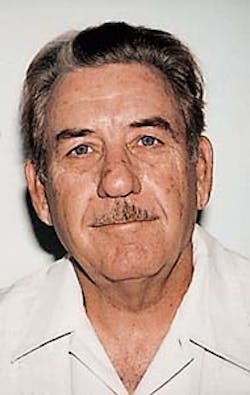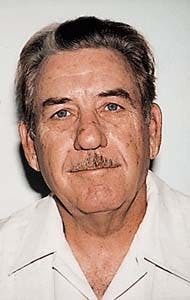Test evaluates high-volume ESP application offshore Mexico
Santiago Guzman AlmazoAn electric submersible pump (ESP) test, although shorter than hoped for, indicated that artificial lift with ESPs had potential for replacing gas-lift operations, offshore Mexico.
Pemex Villahermosa, MexicoGene Riling
Cealc Bartlesville, Okla
Petr?leos Mexicanos (Pemex) recently preformed this test of a high-volume (10,000 b/d) ESP in the Akal reservoir of the Cantarell field, northeast Marina Region in the Gulf of Mexico (Fig. 1 [935,302 bytes]).
In the Marine Region, gas lift is the main artificial lift method; however, to maintain production on gas lift, sweetened gas requirements for the Akal reservoir would have to increase by about 30 MMscfd.
The ESP design was complex because the pump would have to handle 20-40% of free gas at its intake.
Fluid and well bore characteristics included:
- 4.5% H2S
- 3.0% CO2
- 225° F. bottom hole temperature
- 20.8° API gravity oil
- 0.962 specific gas gravity
- 360 scf/bbl GOR
- 0% water cut.
Installed in September 1996, the ESP had to be pulled from the well in November 1997 because of an electrical short. Actual operating time was about 7 months.
Test objectives
Engineering analysis in the EK-Balam field indicated that ESPs would be the preferred economic solution to maintain production. After analyzing the Akal well and reservoir data, two ESP candidates from platform Akal-N were selected for the pilot test.The four objectives for the pilot test were as follows:
- Demonstrate the potential of incremental production with ESPs
- Test ESP performance and ability to handle free gas in the Akal environment
- Determine economic feasibility of ESPs
- Demonstrate feasibility of downhole measurements for improved reservoir management.
Pump environment
The two candidate wells had good production, pressure-volume-temperature (PVT), and productivity index (PI) data.Inflow performance relationships (IPRs) calculated on both wells indicated that the ESP would limit production and not the well producing capacity.
The major unknown was the amount of free gas that would be experienced at the pump's intake. Calculations indicated that with a pump set low in the 7-in. casing, the free gas would be in the 20-30% range. At a higher setting depth, in the 95/8-in. casing, the free gas could be as high as 40%.
Because of the casing and the corrosive environment, it was decided that a deep-set packer (non-venting) must be installed.
This meant that the pump would have to handle all production.
Pump design
Well C-1082 on platform Alka-N was selected for the ESP installation. The well produced 4,455 st-tk bo/d on gas lift.The ESP was set in the 7-in., 32 lb/ft casing about 150 ft above the perforations. This limited production because of the physical limitations of ESP equipment in that size of casing.
The ESP was rated to handle 10,000 st-tk bo/d at 65 hz. This design was based on protecting the casing from the corrosive produced fluid and minimizing free gas at the pump intake on this particular well.
The packer prevented the installation of conventional gas separators for venting gas to the annulus.
Pemex decided to install the relatively new advanced gas handler (AGH). The AGH had some operating history and had been tested in the laboratory, but its performance at high producing rates and with free gas was unknown.
The largest AGH available generates 54 hp while handling water, specific gravity 1.0. The AGH also provides some lift (head).
Several ESP installation designs were evaluated with a subpump computer program. The pump computer program had difficulties providing answers because of the high percentage of free gas at the intake caused by not having a gas separator. Therefore, some old-fashioned practical engineering, based on experience, was included in the pump design.
The final design for Well C-1082 was based on an estimate of 25% free gas at the intake.
Table 1 [53,466 bytes] summarizes the final design for the submersible pump.
Downhole equipment
Equipment specifications included high temperature, high strength, and high-grade metallurgies for all downhole components.A downhole monitoring tool (DMST) was placed at the bottom of the motor for recording bottom hole temperature and the motor's winding temperature. DMST adapters were installed at the pump's intake and discharge to measure pressures at these points.
Downhole equipment included two pumps in tandem and the AGH. Each pump had 46 stages, and the AGH had 18 stages. The protector was a single unit with multiple labyrinths and bags. A 400-hp motor or two 200-hp motors in tandem were required. Unit OD was 5.4 in.
The upper power cable was No. 1 round, high temperature, solid conductor, double armored. The cable below the packer was No. 4 lead flat, high temperature, armored.
Protectors were placed throughout the installation, and a motor guide was run below the sensor.
Where possible, standard oil field equipment was specified for both the downhole and surface equipment. Because of its availability, the tubing consisted of 3.5-in. new VAM in the 7-in., 32 lb/ft casing and 4.5-in. new VAM in the 95/8-in., 47 lb/ft casing.
Fig. 2 [2,039,096 bytes] shows the downhole completion of Well C-1082.
Surface equipment
The surface equipment was designed for 500 kva. A special control room housed the variable-speed drive, supervisory control and data acquisition (scada) system, and related equipment. It also contained gas detection, fire detection, harmonic filtering system, and air conditioning equipment.The control room and all external transformers were skid mounted. Power to the system was provided by a skid-mounted generator. API, IEEE, and Pemex specifications were strenuously adhered to.
Operating history
Some minor, but costly delays were experience with the surface equipment shortly after starting-up the ESP. These delays were caused by small components such as fuse sizes, etc. All problems were documented and will be corrected in future supplier specifications.Costly delays were also experienced with the generator operations. There is no doubt that operations would have been much smoother with a sound primary power source; however, for this pilot installation, a generator for providing power could not be avoided.
Production in the well declined, and it was assumed that this downhole problem was caused by carbonate scale because acidizing and diesel oil washing returned the well's production rate back to normal.
After production continued to decline steadily over a 2-month period, Pemex decided to acid-treat the well every 2 months to maintain the production rate.
Production history
The ESP was in the well from September 1996 until November 1997. During that time, production tests ranged from 6,100 to 9,400 st-tk bo/d with an average production rate, over the 7-month producing period, of 8,000 bo/d at 60 hz.Table 2 [68,751 bytes] shows some of the tests and pressures.
Gas production at the higher oil rates ranged from 60,000 to 80,000 cu m/day (2.1-2.8 MMcfd). The pump intake pressure remained constant at about 1,400 psi. At the bottom hole temperature of 210° F., the motor windings operated at 300° F.
The discharge pressure varied with the production and proved to be a very valuable information. The ESP operation was relatively smooth. The amp-chart did not indicate any gas interference problems. The horsepower load and amperage were very close to the estimated design criteria.
The unit suddenly failed with a downhole short in August 1997, after a 7 month run. The electrical readings with a volt/ohm meter showed the unit was balanced phase-to-phase with the same readings that were recorded at the time of the installation.
The unit's phase-to-ground checked zero on all three legs. A check of all of the parameters being monitored showed that the unit was operating normally, and no disturbances had occurred. The failure looked as if someone had pulled the electrical plug.
After pulling the ESP on Sept. 30, 1997, Pemex found that the failure occurred in one phase of the flat cable where it exited the penetrator at the lower end of the packer.
The failure was one phase-to-ground. No internal damage was found in the penetrator when it was dissected. Because the failure occurred after the ESP was in the well for a long period, it can only be surmised that the breakdown was due to cable expansion and contraction and/or the effects of acidizing.
No signs of gas penetration or swelling were found in the cable below the packer.
The DMST was damaged internally because of repeated restart attempts. Surprisingly, no visual signs of any scale on the production tubing, cable, or equipment were seen.
The rotational checks of the pumps and AGH were not abnormal. Both motors checked out electrically.
The pulled ESP will be sent back to the manufacturer for a complete teardown and inspection of all components. A complete check will be made of any wear patterns that developed during the 7-month run.
If the pumps are found free of scale and plugging during the inspection, Pemex will have to find another cause for the production declines. Currently, it is assumed that the production declines may have been caused by some type of gas interference or gas pockets.
Prior to acidizing, the normal operation of reversing the leads, etc., were tried without success. It is very possible that a simple backflush with pressure may have cleared the obstruction.
Analysis
The goal for the ESP pilot operation was hopefully a 1-year run life. However, the incremental production averaged 3,500 bo/d over the previously installed gas lift system, so the economics and potential for the ESPs is evident.The ESP installation in the 7-in. casing handled the free gas very well at the volume being produced. The 10,000 st-tk bo/d design volume was never reached. However, it is now believed that with some design modifications this rate or more is obtainable from a 7-in. casing installation with an ESP in the Akal wells.
The information provided by the DMST was very valuable. A complete analysis of the well's operation can be made by combining the information of bottom hole temperature, pump intake pressure, pump discharge pressure, wellhead temperature, system pressure, and production rates.
It was very evident that a small decrease in the pump's discharge pressure resulted in a sizeable decrease in production on these high-volume wells. To minimize friction losses on future installations, the largest size tubing string and equipment bores possible will be used.
Although the run time for the Akal installation was disappointing, the installation of this initial pilot test has provided some valuable information for future installations.
Pemex has several on-going successful ESP operations, but the volumes being produced are less than those being attempted in the Cantarell field. Plans are now in progress for installing two higher volume units on the Nohoch-A platform; one design rate of 15,000 st-tk bo/d and one for 20,000 st-tk bo/d.
The completions of these higher volume units will be in the 95/8-in. casing, with at least one well using a venting packer.
Pemex Cantarell has prepared a comprehensive installation and pulling ESP procedures manual for their personnel. This manual, in conjunction with a comprehensive operating manual, is to ensure that proper procedures are followed when working with ESPs.
The costly installation and pulling of an ESP unit offshore must be considered when evaluating the economics. If Pemex can experience 1 year or greater ESP run lives in the Cantarell high-volume wells, then ESPs will be the economical solution to maintaining production.
The Authors
Copyright 1997 Oil & Gas Journal. All Rights Reserved.

